Infrastructure Challenges Faced by Small Businesses
VerifiedAdded on 2020/04/01
|17
|3397
|48
AI Summary
The study delves into significant determinants influencing SME performance within developing nations, focusing on five primary factors: inadequate credit facilities, poor infrastructure, lack of managerial skills, restrictive government policies, and limited access to vital business information. By examining these aspects, the paper aims to provide insights into how SMEs can overcome obstacles to enhance their competitiveness and growth. Financial management emerges as a crucial element, with effective strategies linked directly to improved performance outcomes. The role of government policies is scrutinized to understand their dual nature—both supportive and restrictive—in shaping business environments for SMEs. Managerial skills are highlighted as essential for strategic decision-making and operational efficiency. Infrastructure deficiencies present substantial barriers that necessitate innovative solutions to ensure sustainable business operations. Lastly, access to information is underscored as a pivotal resource enabling SMEs to adapt and thrive in dynamic markets. Through comprehensive analysis and empirical evidence, this paper proposes actionable recommendations for policymakers, entrepreneurs, and stakeholders committed to fostering a robust SME sector.
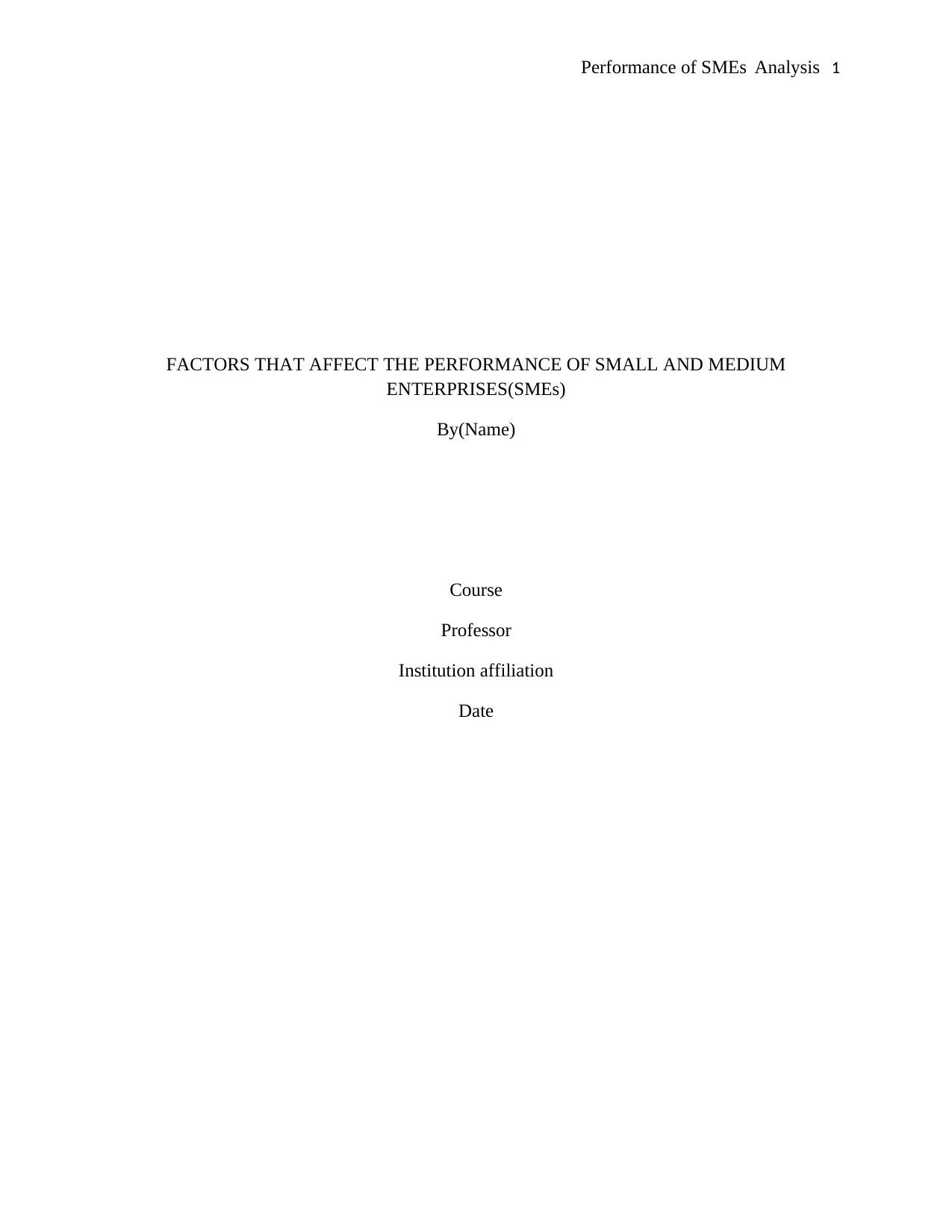
Performance of SMEs Analysis 1
FACTORS THAT AFFECT THE PERFORMANCE OF SMALL AND MEDIUM
ENTERPRISES(SMEs)
By(Name)
Course
Professor
Institution affiliation
Date
FACTORS THAT AFFECT THE PERFORMANCE OF SMALL AND MEDIUM
ENTERPRISES(SMEs)
By(Name)
Course
Professor
Institution affiliation
Date
Paraphrase This Document
Need a fresh take? Get an instant paraphrase of this document with our AI Paraphraser
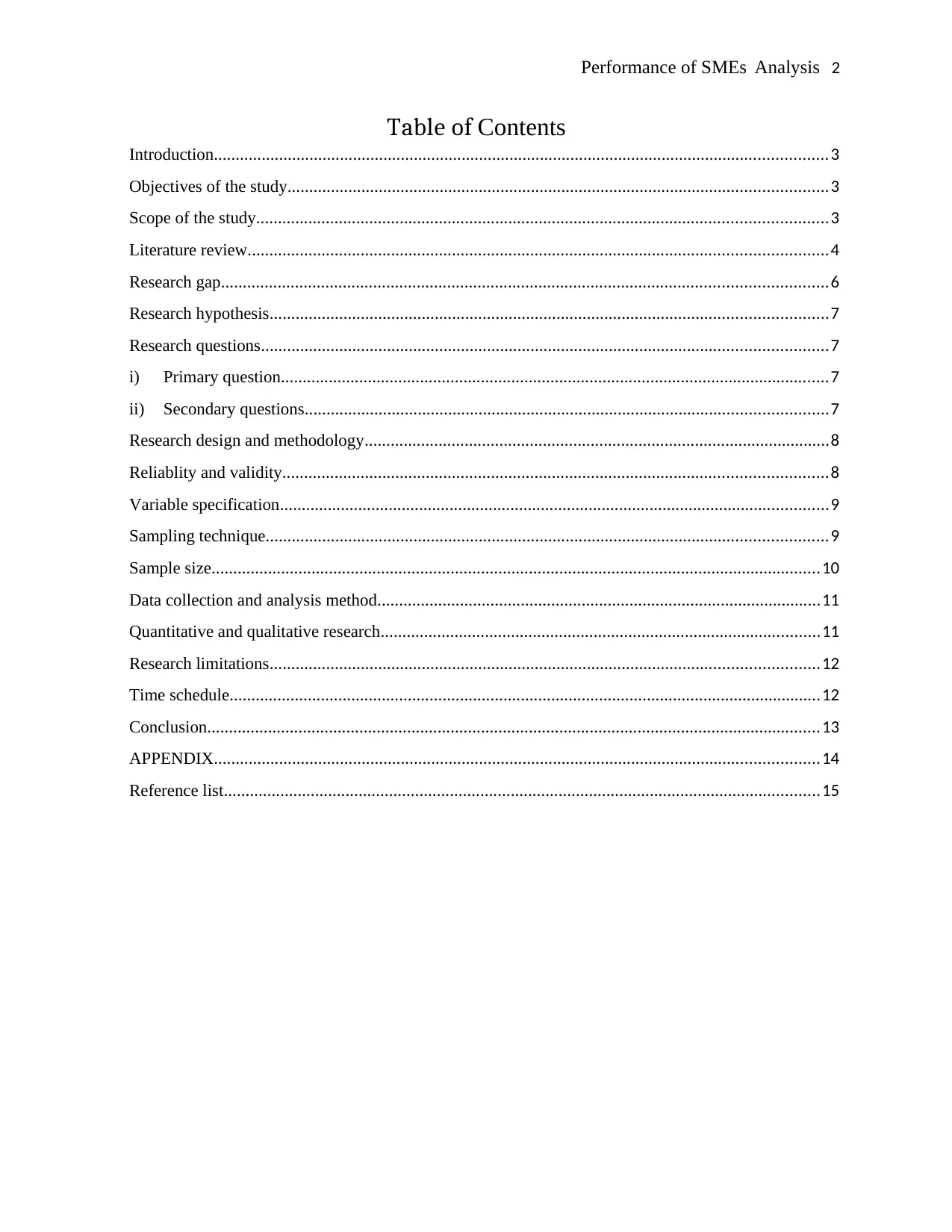
Performance of SMEs Analysis 2
Table of Contents
Introduction.............................................................................................................................................3
Objectives of the study............................................................................................................................3
Scope of the study...................................................................................................................................3
Literature review.....................................................................................................................................4
Research gap...........................................................................................................................................6
Research hypothesis................................................................................................................................7
Research questions..................................................................................................................................7
i) Primary question..............................................................................................................................7
ii) Secondary questions........................................................................................................................7
Research design and methodology...........................................................................................................8
Reliablity and validity.............................................................................................................................8
Variable specification..............................................................................................................................9
Sampling technique.................................................................................................................................9
Sample size............................................................................................................................................10
Data collection and analysis method......................................................................................................11
Quantitative and qualitative research.....................................................................................................11
Research limitations..............................................................................................................................12
Time schedule........................................................................................................................................12
Conclusion.............................................................................................................................................13
APPENDIX...........................................................................................................................................14
Reference list.........................................................................................................................................15
Table of Contents
Introduction.............................................................................................................................................3
Objectives of the study............................................................................................................................3
Scope of the study...................................................................................................................................3
Literature review.....................................................................................................................................4
Research gap...........................................................................................................................................6
Research hypothesis................................................................................................................................7
Research questions..................................................................................................................................7
i) Primary question..............................................................................................................................7
ii) Secondary questions........................................................................................................................7
Research design and methodology...........................................................................................................8
Reliablity and validity.............................................................................................................................8
Variable specification..............................................................................................................................9
Sampling technique.................................................................................................................................9
Sample size............................................................................................................................................10
Data collection and analysis method......................................................................................................11
Quantitative and qualitative research.....................................................................................................11
Research limitations..............................................................................................................................12
Time schedule........................................................................................................................................12
Conclusion.............................................................................................................................................13
APPENDIX...........................................................................................................................................14
Reference list.........................................................................................................................................15
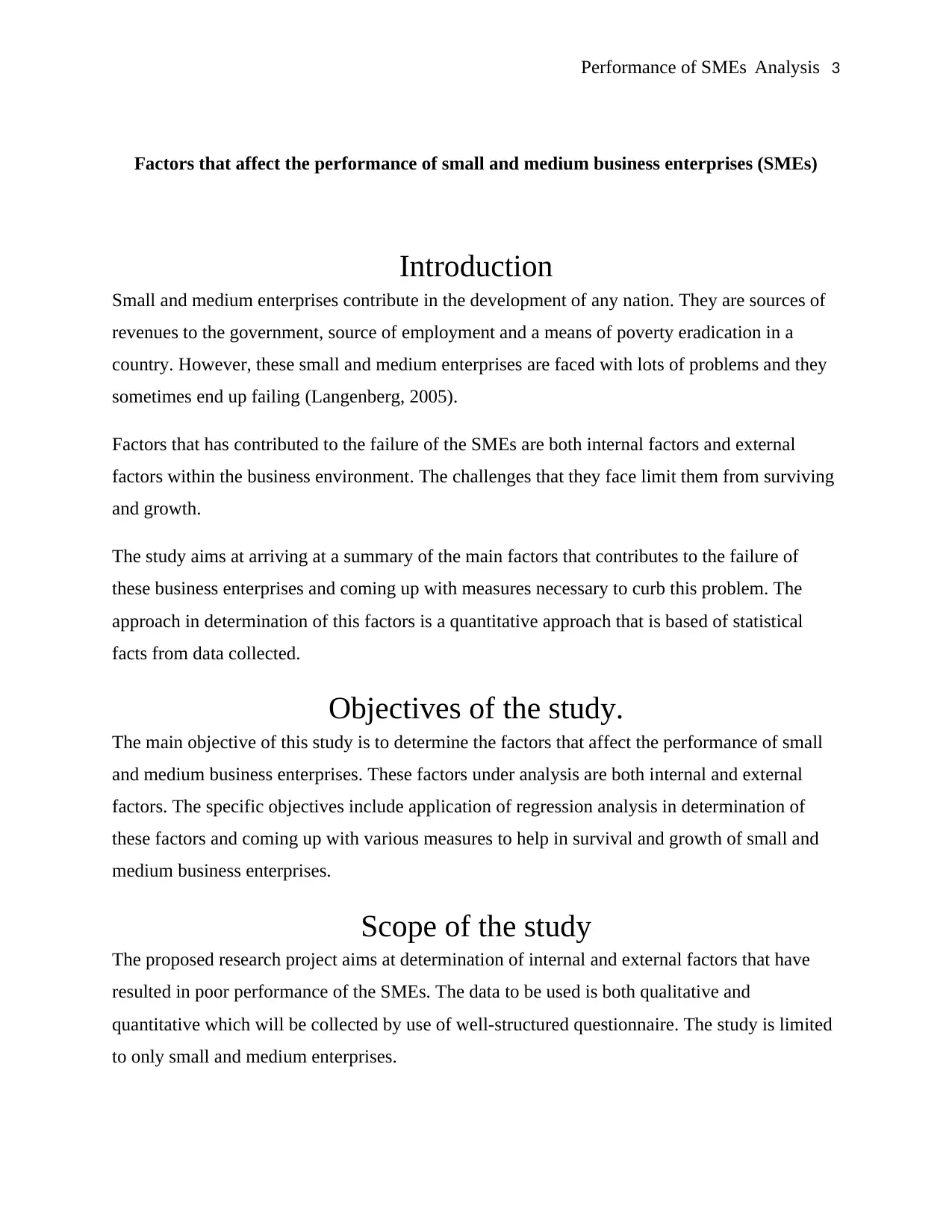
Performance of SMEs Analysis 3
Factors that affect the performance of small and medium business enterprises (SMEs)
Introduction
Small and medium enterprises contribute in the development of any nation. They are sources of
revenues to the government, source of employment and a means of poverty eradication in a
country. However, these small and medium enterprises are faced with lots of problems and they
sometimes end up failing (Langenberg, 2005).
Factors that has contributed to the failure of the SMEs are both internal factors and external
factors within the business environment. The challenges that they face limit them from surviving
and growth.
The study aims at arriving at a summary of the main factors that contributes to the failure of
these business enterprises and coming up with measures necessary to curb this problem. The
approach in determination of this factors is a quantitative approach that is based of statistical
facts from data collected.
Objectives of the study.
The main objective of this study is to determine the factors that affect the performance of small
and medium business enterprises. These factors under analysis are both internal and external
factors. The specific objectives include application of regression analysis in determination of
these factors and coming up with various measures to help in survival and growth of small and
medium business enterprises.
Scope of the study
The proposed research project aims at determination of internal and external factors that have
resulted in poor performance of the SMEs. The data to be used is both qualitative and
quantitative which will be collected by use of well-structured questionnaire. The study is limited
to only small and medium enterprises.
Factors that affect the performance of small and medium business enterprises (SMEs)
Introduction
Small and medium enterprises contribute in the development of any nation. They are sources of
revenues to the government, source of employment and a means of poverty eradication in a
country. However, these small and medium enterprises are faced with lots of problems and they
sometimes end up failing (Langenberg, 2005).
Factors that has contributed to the failure of the SMEs are both internal factors and external
factors within the business environment. The challenges that they face limit them from surviving
and growth.
The study aims at arriving at a summary of the main factors that contributes to the failure of
these business enterprises and coming up with measures necessary to curb this problem. The
approach in determination of this factors is a quantitative approach that is based of statistical
facts from data collected.
Objectives of the study.
The main objective of this study is to determine the factors that affect the performance of small
and medium business enterprises. These factors under analysis are both internal and external
factors. The specific objectives include application of regression analysis in determination of
these factors and coming up with various measures to help in survival and growth of small and
medium business enterprises.
Scope of the study
The proposed research project aims at determination of internal and external factors that have
resulted in poor performance of the SMEs. The data to be used is both qualitative and
quantitative which will be collected by use of well-structured questionnaire. The study is limited
to only small and medium enterprises.
⊘ This is a preview!⊘
Do you want full access?
Subscribe today to unlock all pages.

Trusted by 1+ million students worldwide
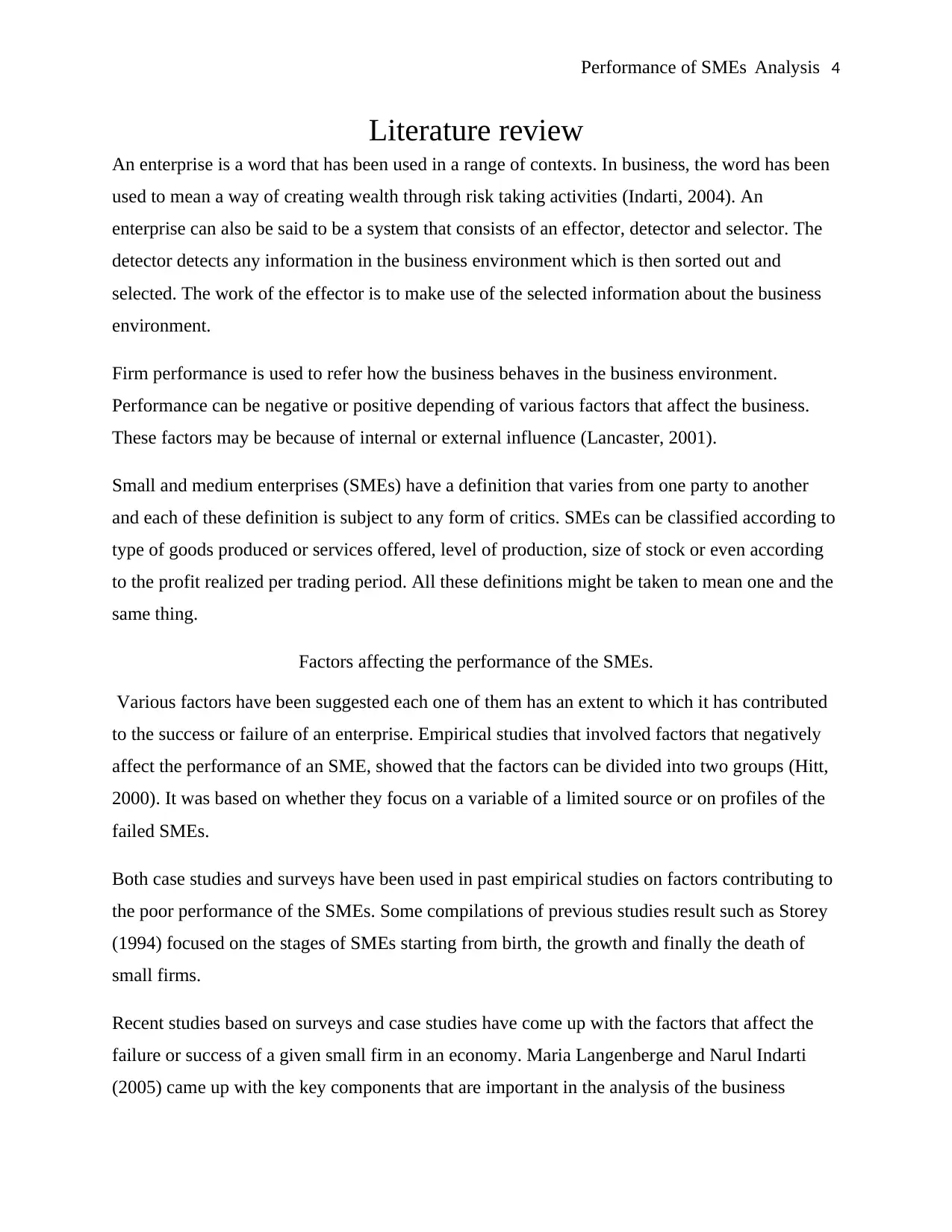
Performance of SMEs Analysis 4
Literature review
An enterprise is a word that has been used in a range of contexts. In business, the word has been
used to mean a way of creating wealth through risk taking activities (Indarti, 2004). An
enterprise can also be said to be a system that consists of an effector, detector and selector. The
detector detects any information in the business environment which is then sorted out and
selected. The work of the effector is to make use of the selected information about the business
environment.
Firm performance is used to refer how the business behaves in the business environment.
Performance can be negative or positive depending of various factors that affect the business.
These factors may be because of internal or external influence (Lancaster, 2001).
Small and medium enterprises (SMEs) have a definition that varies from one party to another
and each of these definition is subject to any form of critics. SMEs can be classified according to
type of goods produced or services offered, level of production, size of stock or even according
to the profit realized per trading period. All these definitions might be taken to mean one and the
same thing.
Factors affecting the performance of the SMEs.
Various factors have been suggested each one of them has an extent to which it has contributed
to the success or failure of an enterprise. Empirical studies that involved factors that negatively
affect the performance of an SME, showed that the factors can be divided into two groups (Hitt,
2000). It was based on whether they focus on a variable of a limited source or on profiles of the
failed SMEs.
Both case studies and surveys have been used in past empirical studies on factors contributing to
the poor performance of the SMEs. Some compilations of previous studies result such as Storey
(1994) focused on the stages of SMEs starting from birth, the growth and finally the death of
small firms.
Recent studies based on surveys and case studies have come up with the factors that affect the
failure or success of a given small firm in an economy. Maria Langenberge and Narul Indarti
(2005) came up with the key components that are important in the analysis of the business
Literature review
An enterprise is a word that has been used in a range of contexts. In business, the word has been
used to mean a way of creating wealth through risk taking activities (Indarti, 2004). An
enterprise can also be said to be a system that consists of an effector, detector and selector. The
detector detects any information in the business environment which is then sorted out and
selected. The work of the effector is to make use of the selected information about the business
environment.
Firm performance is used to refer how the business behaves in the business environment.
Performance can be negative or positive depending of various factors that affect the business.
These factors may be because of internal or external influence (Lancaster, 2001).
Small and medium enterprises (SMEs) have a definition that varies from one party to another
and each of these definition is subject to any form of critics. SMEs can be classified according to
type of goods produced or services offered, level of production, size of stock or even according
to the profit realized per trading period. All these definitions might be taken to mean one and the
same thing.
Factors affecting the performance of the SMEs.
Various factors have been suggested each one of them has an extent to which it has contributed
to the success or failure of an enterprise. Empirical studies that involved factors that negatively
affect the performance of an SME, showed that the factors can be divided into two groups (Hitt,
2000). It was based on whether they focus on a variable of a limited source or on profiles of the
failed SMEs.
Both case studies and surveys have been used in past empirical studies on factors contributing to
the poor performance of the SMEs. Some compilations of previous studies result such as Storey
(1994) focused on the stages of SMEs starting from birth, the growth and finally the death of
small firms.
Recent studies based on surveys and case studies have come up with the factors that affect the
failure or success of a given small firm in an economy. Maria Langenberge and Narul Indarti
(2005) came up with the key components that are important in the analysis of the business
Paraphrase This Document
Need a fresh take? Get an instant paraphrase of this document with our AI Paraphraser
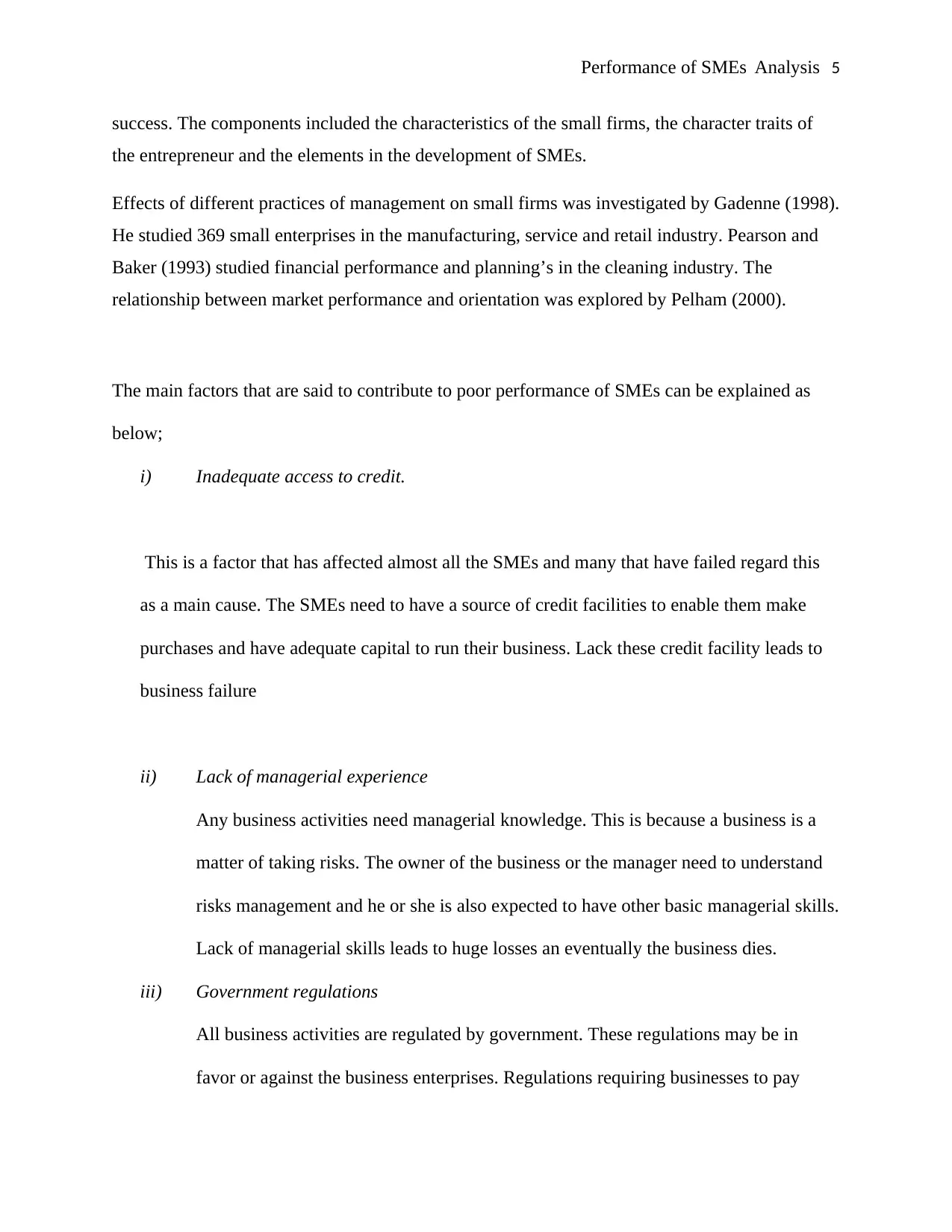
Performance of SMEs Analysis 5
success. The components included the characteristics of the small firms, the character traits of
the entrepreneur and the elements in the development of SMEs.
Effects of different practices of management on small firms was investigated by Gadenne (1998).
He studied 369 small enterprises in the manufacturing, service and retail industry. Pearson and
Baker (1993) studied financial performance and planning’s in the cleaning industry. The
relationship between market performance and orientation was explored by Pelham (2000).
The main factors that are said to contribute to poor performance of SMEs can be explained as
below;
i) Inadequate access to credit.
This is a factor that has affected almost all the SMEs and many that have failed regard this
as a main cause. The SMEs need to have a source of credit facilities to enable them make
purchases and have adequate capital to run their business. Lack these credit facility leads to
business failure
ii) Lack of managerial experience
Any business activities need managerial knowledge. This is because a business is a
matter of taking risks. The owner of the business or the manager need to understand
risks management and he or she is also expected to have other basic managerial skills.
Lack of managerial skills leads to huge losses an eventually the business dies.
iii) Government regulations
All business activities are regulated by government. These regulations may be in
favor or against the business enterprises. Regulations requiring businesses to pay
success. The components included the characteristics of the small firms, the character traits of
the entrepreneur and the elements in the development of SMEs.
Effects of different practices of management on small firms was investigated by Gadenne (1998).
He studied 369 small enterprises in the manufacturing, service and retail industry. Pearson and
Baker (1993) studied financial performance and planning’s in the cleaning industry. The
relationship between market performance and orientation was explored by Pelham (2000).
The main factors that are said to contribute to poor performance of SMEs can be explained as
below;
i) Inadequate access to credit.
This is a factor that has affected almost all the SMEs and many that have failed regard this
as a main cause. The SMEs need to have a source of credit facilities to enable them make
purchases and have adequate capital to run their business. Lack these credit facility leads to
business failure
ii) Lack of managerial experience
Any business activities need managerial knowledge. This is because a business is a
matter of taking risks. The owner of the business or the manager need to understand
risks management and he or she is also expected to have other basic managerial skills.
Lack of managerial skills leads to huge losses an eventually the business dies.
iii) Government regulations
All business activities are regulated by government. These regulations may be in
favor or against the business enterprises. Regulations requiring businesses to pay
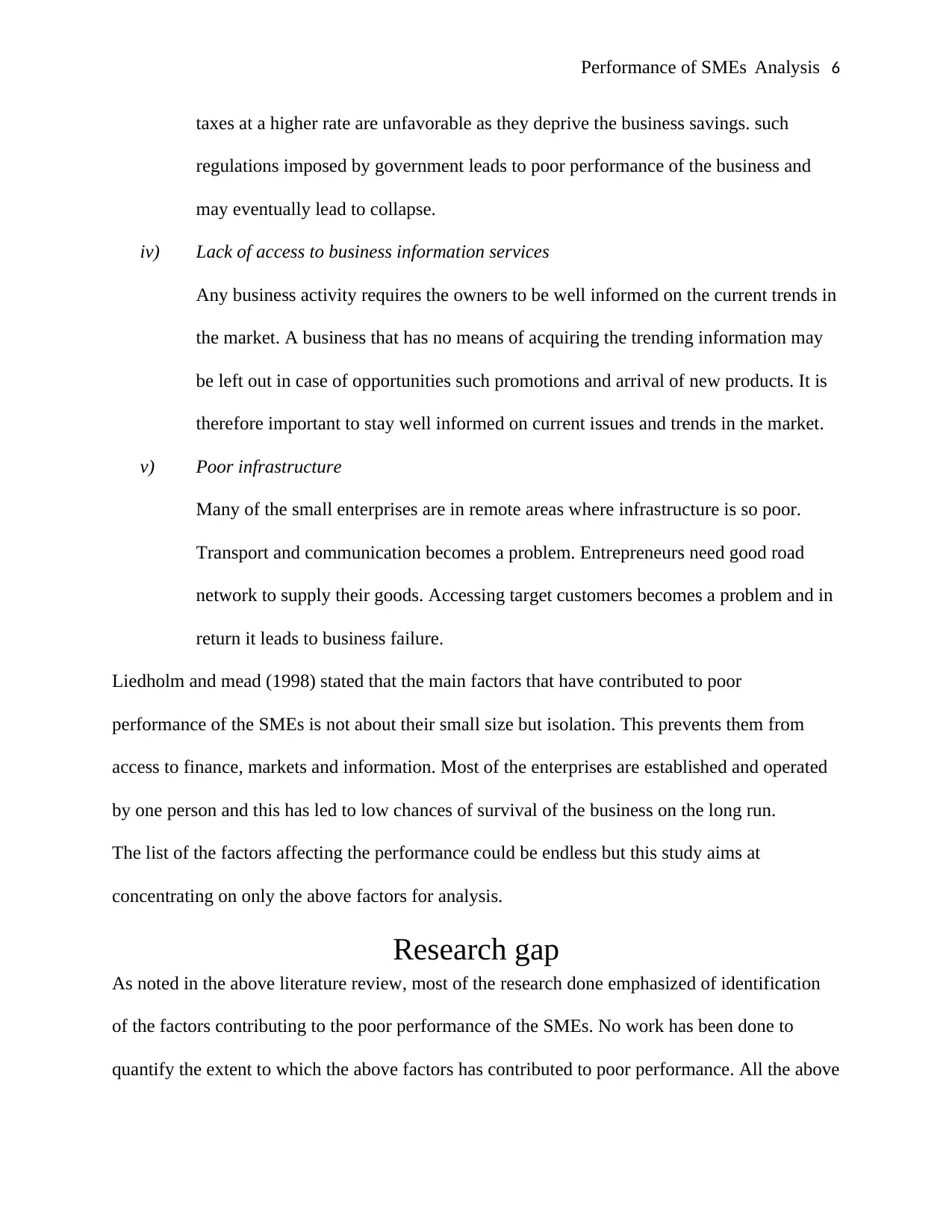
Performance of SMEs Analysis 6
taxes at a higher rate are unfavorable as they deprive the business savings. such
regulations imposed by government leads to poor performance of the business and
may eventually lead to collapse.
iv) Lack of access to business information services
Any business activity requires the owners to be well informed on the current trends in
the market. A business that has no means of acquiring the trending information may
be left out in case of opportunities such promotions and arrival of new products. It is
therefore important to stay well informed on current issues and trends in the market.
v) Poor infrastructure
Many of the small enterprises are in remote areas where infrastructure is so poor.
Transport and communication becomes a problem. Entrepreneurs need good road
network to supply their goods. Accessing target customers becomes a problem and in
return it leads to business failure.
Liedholm and mead (1998) stated that the main factors that have contributed to poor
performance of the SMEs is not about their small size but isolation. This prevents them from
access to finance, markets and information. Most of the enterprises are established and operated
by one person and this has led to low chances of survival of the business on the long run.
The list of the factors affecting the performance could be endless but this study aims at
concentrating on only the above factors for analysis.
Research gap
As noted in the above literature review, most of the research done emphasized of identification
of the factors contributing to the poor performance of the SMEs. No work has been done to
quantify the extent to which the above factors has contributed to poor performance. All the above
taxes at a higher rate are unfavorable as they deprive the business savings. such
regulations imposed by government leads to poor performance of the business and
may eventually lead to collapse.
iv) Lack of access to business information services
Any business activity requires the owners to be well informed on the current trends in
the market. A business that has no means of acquiring the trending information may
be left out in case of opportunities such promotions and arrival of new products. It is
therefore important to stay well informed on current issues and trends in the market.
v) Poor infrastructure
Many of the small enterprises are in remote areas where infrastructure is so poor.
Transport and communication becomes a problem. Entrepreneurs need good road
network to supply their goods. Accessing target customers becomes a problem and in
return it leads to business failure.
Liedholm and mead (1998) stated that the main factors that have contributed to poor
performance of the SMEs is not about their small size but isolation. This prevents them from
access to finance, markets and information. Most of the enterprises are established and operated
by one person and this has led to low chances of survival of the business on the long run.
The list of the factors affecting the performance could be endless but this study aims at
concentrating on only the above factors for analysis.
Research gap
As noted in the above literature review, most of the research done emphasized of identification
of the factors contributing to the poor performance of the SMEs. No work has been done to
quantify the extent to which the above factors has contributed to poor performance. All the above
⊘ This is a preview!⊘
Do you want full access?
Subscribe today to unlock all pages.

Trusted by 1+ million students worldwide
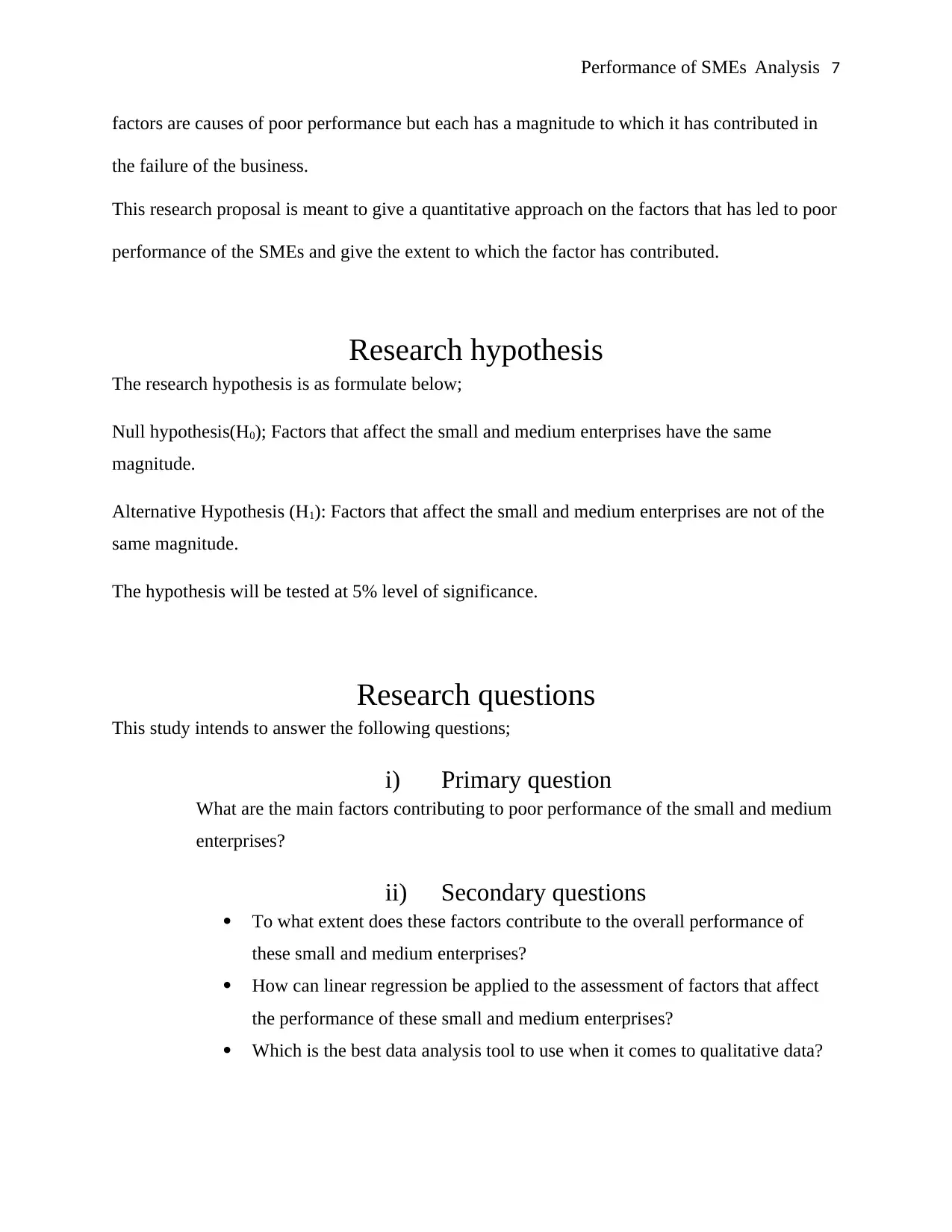
Performance of SMEs Analysis 7
factors are causes of poor performance but each has a magnitude to which it has contributed in
the failure of the business.
This research proposal is meant to give a quantitative approach on the factors that has led to poor
performance of the SMEs and give the extent to which the factor has contributed.
Research hypothesis
The research hypothesis is as formulate below;
Null hypothesis(H0); Factors that affect the small and medium enterprises have the same
magnitude.
Alternative Hypothesis (H1): Factors that affect the small and medium enterprises are not of the
same magnitude.
The hypothesis will be tested at 5% level of significance.
Research questions
This study intends to answer the following questions;
i) Primary question
What are the main factors contributing to poor performance of the small and medium
enterprises?
ii) Secondary questions
To what extent does these factors contribute to the overall performance of
these small and medium enterprises?
How can linear regression be applied to the assessment of factors that affect
the performance of these small and medium enterprises?
Which is the best data analysis tool to use when it comes to qualitative data?
factors are causes of poor performance but each has a magnitude to which it has contributed in
the failure of the business.
This research proposal is meant to give a quantitative approach on the factors that has led to poor
performance of the SMEs and give the extent to which the factor has contributed.
Research hypothesis
The research hypothesis is as formulate below;
Null hypothesis(H0); Factors that affect the small and medium enterprises have the same
magnitude.
Alternative Hypothesis (H1): Factors that affect the small and medium enterprises are not of the
same magnitude.
The hypothesis will be tested at 5% level of significance.
Research questions
This study intends to answer the following questions;
i) Primary question
What are the main factors contributing to poor performance of the small and medium
enterprises?
ii) Secondary questions
To what extent does these factors contribute to the overall performance of
these small and medium enterprises?
How can linear regression be applied to the assessment of factors that affect
the performance of these small and medium enterprises?
Which is the best data analysis tool to use when it comes to qualitative data?
Paraphrase This Document
Need a fresh take? Get an instant paraphrase of this document with our AI Paraphraser
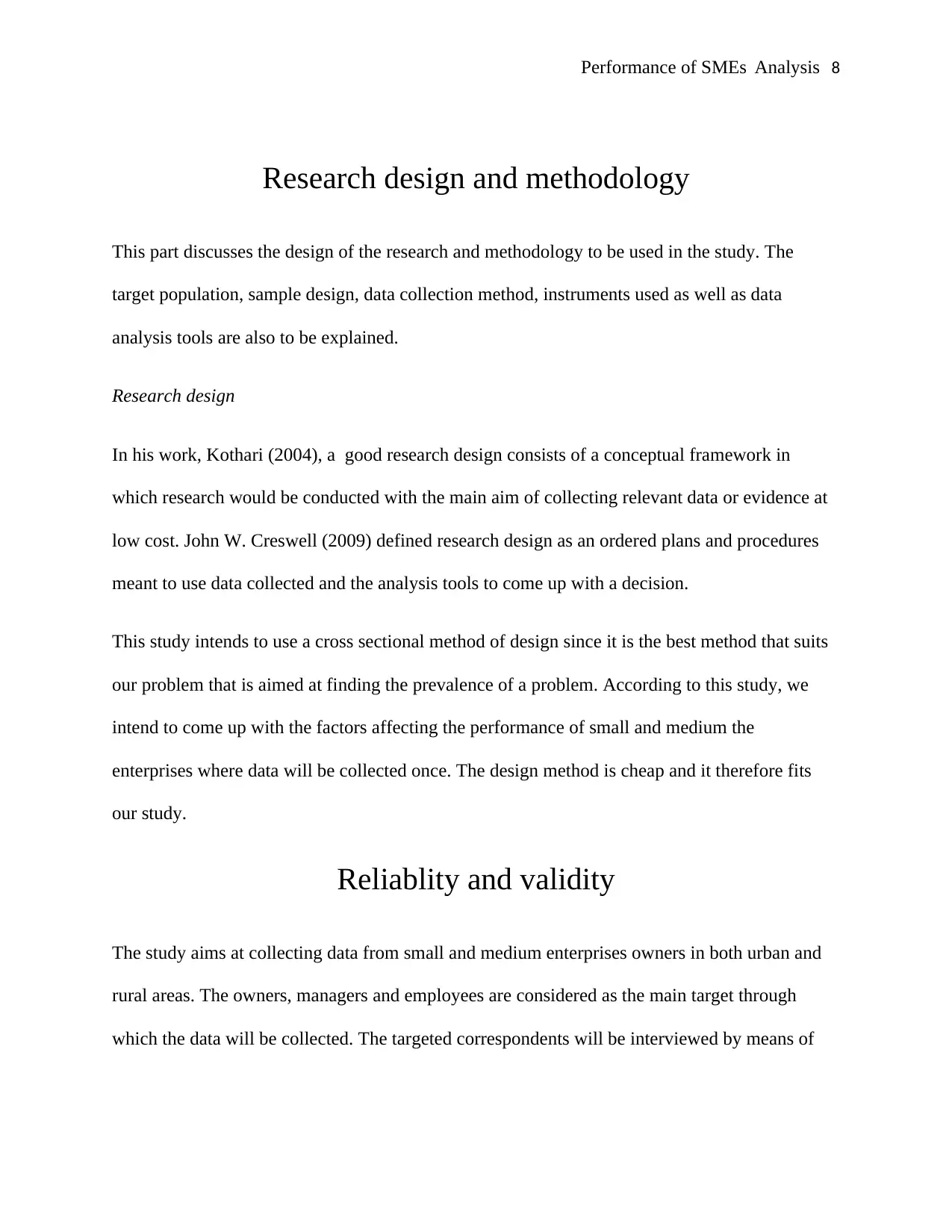
Performance of SMEs Analysis 8
Research design and methodology
This part discusses the design of the research and methodology to be used in the study. The
target population, sample design, data collection method, instruments used as well as data
analysis tools are also to be explained.
Research design
In his work, Kothari (2004), a good research design consists of a conceptual framework in
which research would be conducted with the main aim of collecting relevant data or evidence at
low cost. John W. Creswell (2009) defined research design as an ordered plans and procedures
meant to use data collected and the analysis tools to come up with a decision.
This study intends to use a cross sectional method of design since it is the best method that suits
our problem that is aimed at finding the prevalence of a problem. According to this study, we
intend to come up with the factors affecting the performance of small and medium the
enterprises where data will be collected once. The design method is cheap and it therefore fits
our study.
Reliablity and validity
The study aims at collecting data from small and medium enterprises owners in both urban and
rural areas. The owners, managers and employees are considered as the main target through
which the data will be collected. The targeted correspondents will be interviewed by means of
Research design and methodology
This part discusses the design of the research and methodology to be used in the study. The
target population, sample design, data collection method, instruments used as well as data
analysis tools are also to be explained.
Research design
In his work, Kothari (2004), a good research design consists of a conceptual framework in
which research would be conducted with the main aim of collecting relevant data or evidence at
low cost. John W. Creswell (2009) defined research design as an ordered plans and procedures
meant to use data collected and the analysis tools to come up with a decision.
This study intends to use a cross sectional method of design since it is the best method that suits
our problem that is aimed at finding the prevalence of a problem. According to this study, we
intend to come up with the factors affecting the performance of small and medium the
enterprises where data will be collected once. The design method is cheap and it therefore fits
our study.
Reliablity and validity
The study aims at collecting data from small and medium enterprises owners in both urban and
rural areas. The owners, managers and employees are considered as the main target through
which the data will be collected. The targeted correspondents will be interviewed by means of
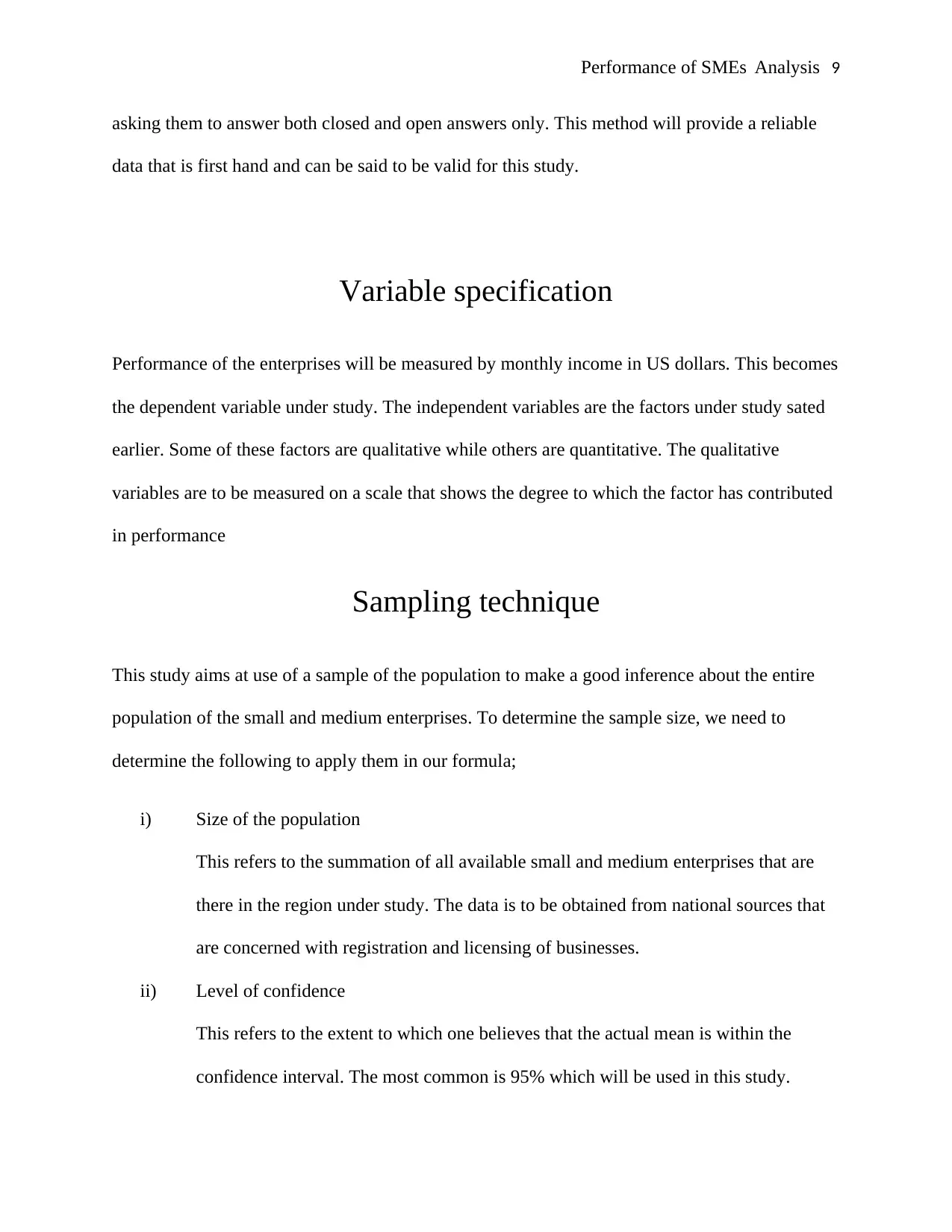
Performance of SMEs Analysis 9
asking them to answer both closed and open answers only. This method will provide a reliable
data that is first hand and can be said to be valid for this study.
Variable specification
Performance of the enterprises will be measured by monthly income in US dollars. This becomes
the dependent variable under study. The independent variables are the factors under study sated
earlier. Some of these factors are qualitative while others are quantitative. The qualitative
variables are to be measured on a scale that shows the degree to which the factor has contributed
in performance
Sampling technique
This study aims at use of a sample of the population to make a good inference about the entire
population of the small and medium enterprises. To determine the sample size, we need to
determine the following to apply them in our formula;
i) Size of the population
This refers to the summation of all available small and medium enterprises that are
there in the region under study. The data is to be obtained from national sources that
are concerned with registration and licensing of businesses.
ii) Level of confidence
This refers to the extent to which one believes that the actual mean is within the
confidence interval. The most common is 95% which will be used in this study.
asking them to answer both closed and open answers only. This method will provide a reliable
data that is first hand and can be said to be valid for this study.
Variable specification
Performance of the enterprises will be measured by monthly income in US dollars. This becomes
the dependent variable under study. The independent variables are the factors under study sated
earlier. Some of these factors are qualitative while others are quantitative. The qualitative
variables are to be measured on a scale that shows the degree to which the factor has contributed
in performance
Sampling technique
This study aims at use of a sample of the population to make a good inference about the entire
population of the small and medium enterprises. To determine the sample size, we need to
determine the following to apply them in our formula;
i) Size of the population
This refers to the summation of all available small and medium enterprises that are
there in the region under study. The data is to be obtained from national sources that
are concerned with registration and licensing of businesses.
ii) Level of confidence
This refers to the extent to which one believes that the actual mean is within the
confidence interval. The most common is 95% which will be used in this study.
⊘ This is a preview!⊘
Do you want full access?
Subscribe today to unlock all pages.

Trusted by 1+ million students worldwide
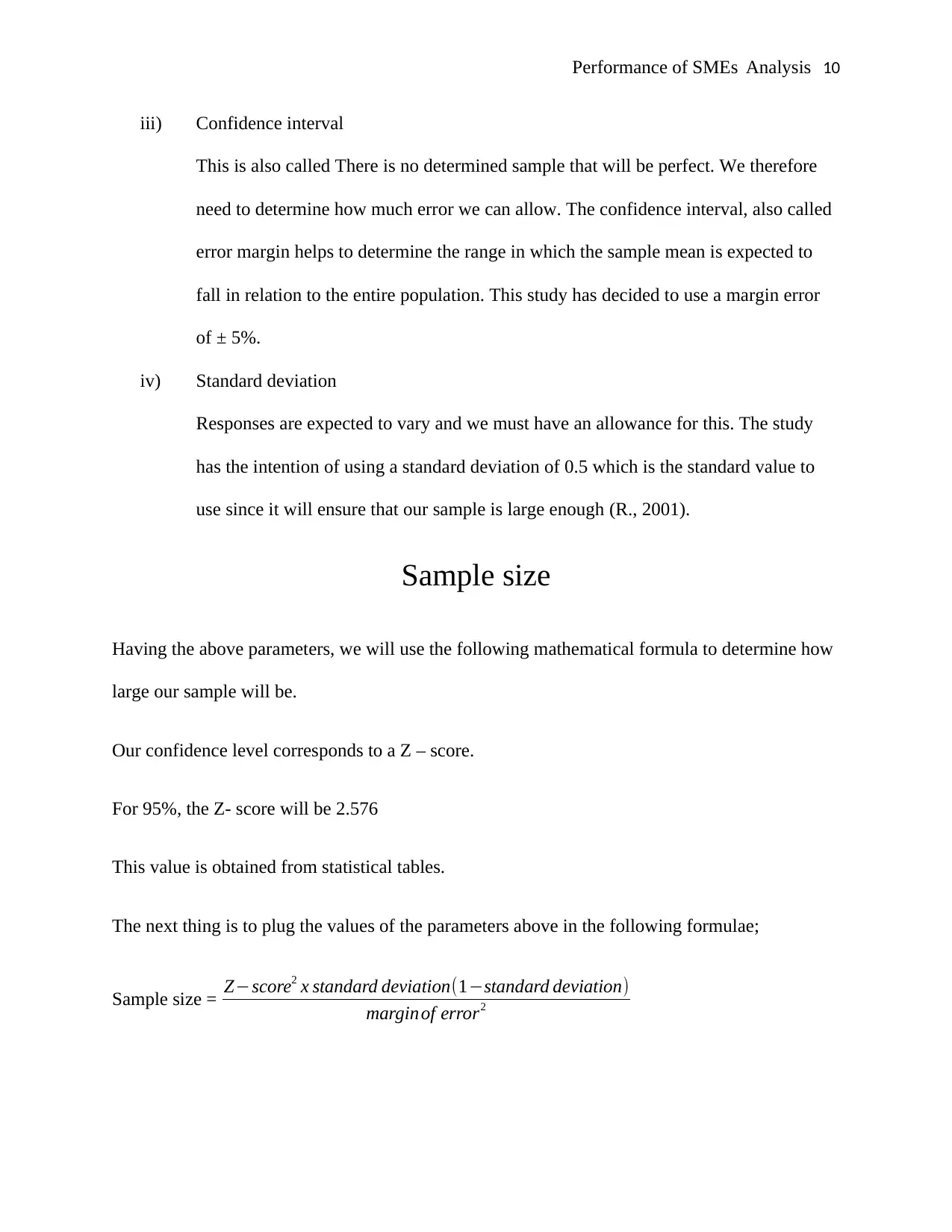
Performance of SMEs Analysis 10
iii) Confidence interval
This is also called There is no determined sample that will be perfect. We therefore
need to determine how much error we can allow. The confidence interval, also called
error margin helps to determine the range in which the sample mean is expected to
fall in relation to the entire population. This study has decided to use a margin error
of ± 5%.
iv) Standard deviation
Responses are expected to vary and we must have an allowance for this. The study
has the intention of using a standard deviation of 0.5 which is the standard value to
use since it will ensure that our sample is large enough (R., 2001).
Sample size
Having the above parameters, we will use the following mathematical formula to determine how
large our sample will be.
Our confidence level corresponds to a Z – score.
For 95%, the Z- score will be 2.576
This value is obtained from statistical tables.
The next thing is to plug the values of the parameters above in the following formulae;
Sample size = Z−score2 x standard deviation(1−standard deviation)
margin of error2
iii) Confidence interval
This is also called There is no determined sample that will be perfect. We therefore
need to determine how much error we can allow. The confidence interval, also called
error margin helps to determine the range in which the sample mean is expected to
fall in relation to the entire population. This study has decided to use a margin error
of ± 5%.
iv) Standard deviation
Responses are expected to vary and we must have an allowance for this. The study
has the intention of using a standard deviation of 0.5 which is the standard value to
use since it will ensure that our sample is large enough (R., 2001).
Sample size
Having the above parameters, we will use the following mathematical formula to determine how
large our sample will be.
Our confidence level corresponds to a Z – score.
For 95%, the Z- score will be 2.576
This value is obtained from statistical tables.
The next thing is to plug the values of the parameters above in the following formulae;
Sample size = Z−score2 x standard deviation(1−standard deviation)
margin of error2
Paraphrase This Document
Need a fresh take? Get an instant paraphrase of this document with our AI Paraphraser
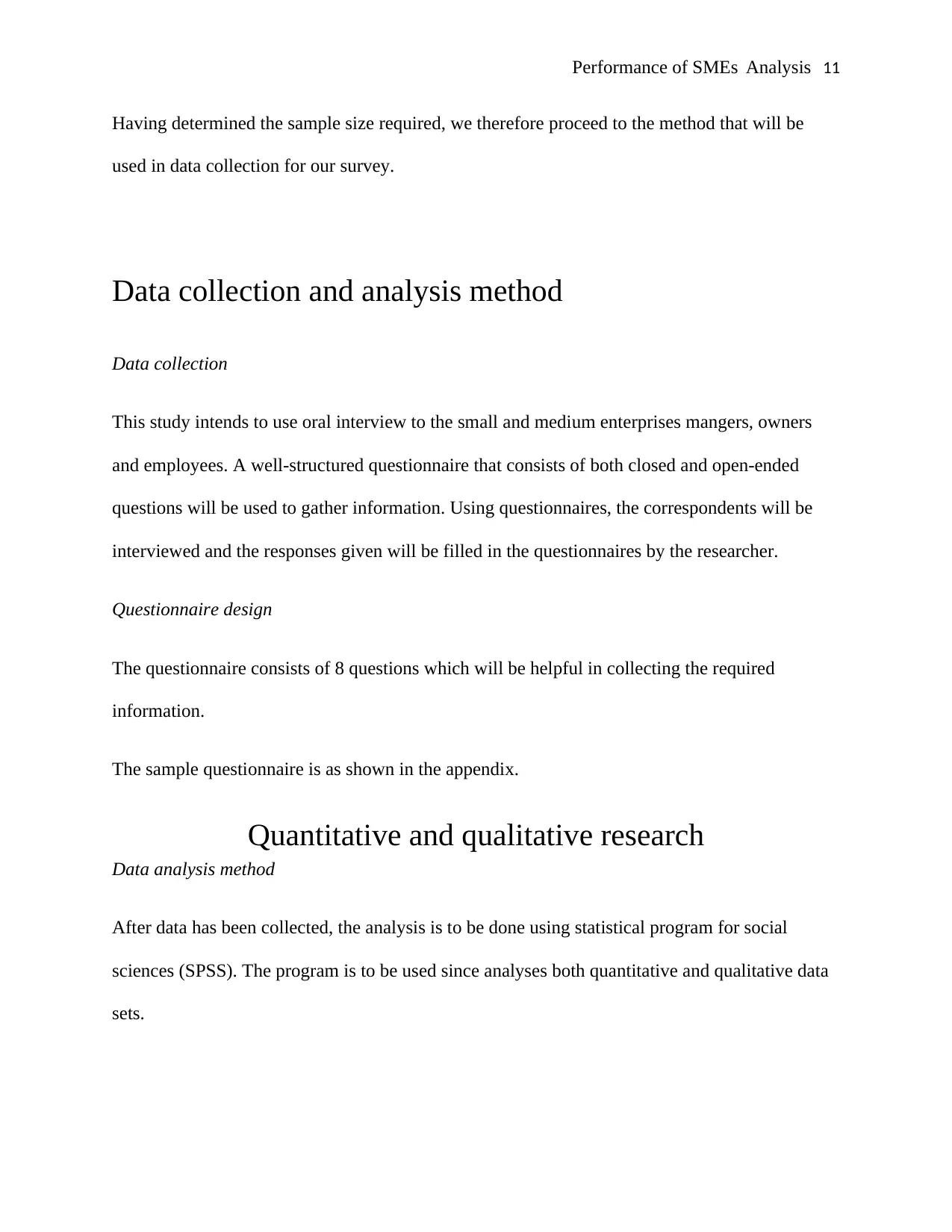
Performance of SMEs Analysis 11
Having determined the sample size required, we therefore proceed to the method that will be
used in data collection for our survey.
Data collection and analysis method
Data collection
This study intends to use oral interview to the small and medium enterprises mangers, owners
and employees. A well-structured questionnaire that consists of both closed and open-ended
questions will be used to gather information. Using questionnaires, the correspondents will be
interviewed and the responses given will be filled in the questionnaires by the researcher.
Questionnaire design
The questionnaire consists of 8 questions which will be helpful in collecting the required
information.
The sample questionnaire is as shown in the appendix.
Quantitative and qualitative research
Data analysis method
After data has been collected, the analysis is to be done using statistical program for social
sciences (SPSS). The program is to be used since analyses both quantitative and qualitative data
sets.
Having determined the sample size required, we therefore proceed to the method that will be
used in data collection for our survey.
Data collection and analysis method
Data collection
This study intends to use oral interview to the small and medium enterprises mangers, owners
and employees. A well-structured questionnaire that consists of both closed and open-ended
questions will be used to gather information. Using questionnaires, the correspondents will be
interviewed and the responses given will be filled in the questionnaires by the researcher.
Questionnaire design
The questionnaire consists of 8 questions which will be helpful in collecting the required
information.
The sample questionnaire is as shown in the appendix.
Quantitative and qualitative research
Data analysis method
After data has been collected, the analysis is to be done using statistical program for social
sciences (SPSS). The program is to be used since analyses both quantitative and qualitative data
sets.
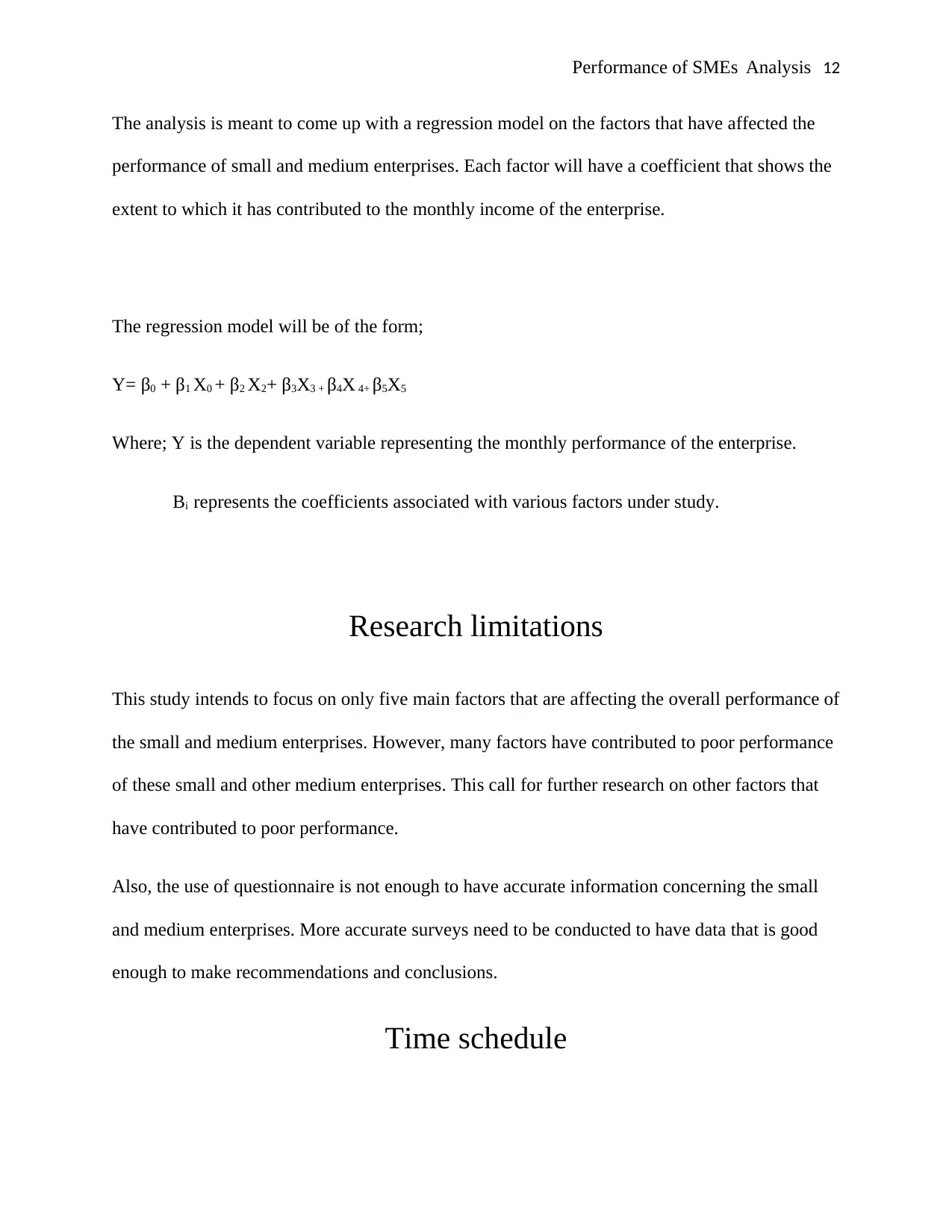
Performance of SMEs Analysis 12
The analysis is meant to come up with a regression model on the factors that have affected the
performance of small and medium enterprises. Each factor will have a coefficient that shows the
extent to which it has contributed to the monthly income of the enterprise.
The regression model will be of the form;
Y= β0 + β1 X0 + β2 X2+ β3X3 + β4X 4+ β5X5
Where; Y is the dependent variable representing the monthly performance of the enterprise.
Bi represents the coefficients associated with various factors under study.
Research limitations
This study intends to focus on only five main factors that are affecting the overall performance of
the small and medium enterprises. However, many factors have contributed to poor performance
of these small and other medium enterprises. This call for further research on other factors that
have contributed to poor performance.
Also, the use of questionnaire is not enough to have accurate information concerning the small
and medium enterprises. More accurate surveys need to be conducted to have data that is good
enough to make recommendations and conclusions.
Time schedule
The analysis is meant to come up with a regression model on the factors that have affected the
performance of small and medium enterprises. Each factor will have a coefficient that shows the
extent to which it has contributed to the monthly income of the enterprise.
The regression model will be of the form;
Y= β0 + β1 X0 + β2 X2+ β3X3 + β4X 4+ β5X5
Where; Y is the dependent variable representing the monthly performance of the enterprise.
Bi represents the coefficients associated with various factors under study.
Research limitations
This study intends to focus on only five main factors that are affecting the overall performance of
the small and medium enterprises. However, many factors have contributed to poor performance
of these small and other medium enterprises. This call for further research on other factors that
have contributed to poor performance.
Also, the use of questionnaire is not enough to have accurate information concerning the small
and medium enterprises. More accurate surveys need to be conducted to have data that is good
enough to make recommendations and conclusions.
Time schedule
⊘ This is a preview!⊘
Do you want full access?
Subscribe today to unlock all pages.

Trusted by 1+ million students worldwide
1 out of 17
Related Documents
Your All-in-One AI-Powered Toolkit for Academic Success.
+13062052269
info@desklib.com
Available 24*7 on WhatsApp / Email
![[object Object]](/_next/static/media/star-bottom.7253800d.svg)
Unlock your academic potential
Copyright © 2020–2025 A2Z Services. All Rights Reserved. Developed and managed by ZUCOL.




